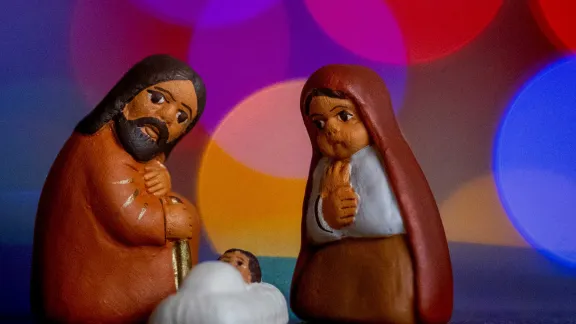Amid the busy celebrations of the festive season, LWF’s President Archbishop Musa invites us all to stop and reflect on the way that God’s love is reflected in the face of a baby born in a stable in Bethlehem over two thousand years ago.

Mary, Joseph and the child Jesus. Photo: LWF/A. Danielsson
In Christmas message, LWF’s President Musa invites us to see God reflected in face of the baby lying in the manger
(LWI) - In his Christmas message, the President of the Lutheran World Federation (LWF) Archbishop Dr Panti Filibus Musa invites Christians worldwide to consider “the astonishing truth” that in the face of a newborn baby in Bethlehem, “we can see the image of God” and his “unending relationship of love” for all of creation.
Reflecting on the words of St Paul’s letter to the Colossians, ‘Christ is the image of the invisible God, the firstborn of all creation’, the LWF leader notes that for many people, the nativity scene, with animals, shepherds and angels welcoming the birth of Mary’s son, is among “our earliest and fondest memories of learning about our faith.”
But if we reflect more deeply on the Incarnation, he continues, “are we able to see, in the face of that tiny baby, the image of the invisible God?” And he asks: “Why did the creator of our universe choose this simple family and this humble stable as the setting for an event that would change the course of history?”
Jesus’ model of servant leadership will turn our earthly models of power and authority upside down.
LWF President Archbishop Dr Panti Filibus Musa
The extraordinary message of Christmas, Archbishop Musa says, “is that through Christ’s birth and earthly life, we can see the image of God, perfectly reflected in his Beloved Son.” The choice of a humble family “in an unremarkable corner of the Roman empire", he adds, is an indicator of the way that Jesus’ model of servant leadership will turn “our earthly models of power and authority upside down.”
The LWF President concludes with a reminder that “we too are created in the image of God and that the invisible love of the Triune God is made visible in and through us.”
Read the full message below
Christ is the image of the invisible God, the firstborn of all creation. For in him all things in heaven and on earth were created, things visible and invisible.
(Col 1:15-16)
For many of us, our earliest and fondest memories of learning about our faith will surely be connected with the Christmas nativity scene. We read books, sing hymns, take part in nativity plays depicting Mary and Joseph with the baby Jesus, surrounded by animals, shepherds and angels welcoming his birth in the stable at Bethlehem.
It's a familiar, comforting image that we recreate each year in our homes, our churches, but also in public places to remind ourselves of the true meaning of Christmas, amid all the hectic shopping and celebrating of this festive season.
But take a closer look for a moment at that new-born baby, wrapped in swaddling bands and laid in the manger, as we read in Luke’s gospel. If we reflect more deeply on the mystery of the Incarnation, of God coming into the world to live among us, are we able to see, in the face of that tiny baby, the image of “the invisible God?” Why did the creator of our universe choose this simple family and this humble stable as the setting for an event that would change the course of history?
We know that Jesus was Mary’s firstborn son, but in his letter to the Colossians, Paul reminds us that he is also “the firstborn of all creation.” John tells us that Christ is the Word that “became flesh and made his dwelling among us.” The same Word that “was with God in the beginning, through him all things were made.”
Scripture teaches us that the Christ-child in the manger is the Son of God, King of kings. But the choice of a Galilean carpenter and a peasant girl in an unremarkable corner of the Roman empire as the family setting for Jesus’ earthly life shows how his kingship is one that turns our earthly models of power and authority upside-down. This will be a radically new model of servant leadership where the Prince of Peace will stoop down to wash his disciples’ dirty feet.
From the Old Testament, we know that we cannot see God’s glory face to face. Yet the extraordinary message of Christmas is that through Christ’s birth and earthly life, we can see the image of God, perfectly reflected in his Beloved Son. The Bible reminds us that we too are created in the image of God and that the invisible love of the Triune God is made visible in and through us.
So, as we make our nativity scenes and prepare once again to welcome the baby in Bethlehem, let us take time to meditate on this astonishing truth. Let us strive to see the image of God in one another, especially in the faces of those often rejected and ignored: the hungry and the persecuted, the refugees and the prisoners, the addicts and the homeless.
I wish you and all your loved ones a very blessed Christmas, as you gaze into the manger and discover anew the face of God, drawing us closer into God’s unending relationship of love.
Archbishop Dr Panti Filibus Musa
President, The Lutheran World Federation


